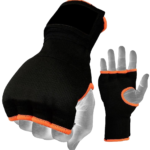“Is jump rope bad for your knees?” is a common inquiry for people who are just starting to hit the gym or are hesitant about buying a jump rope because they heard it can cause tears in the knees.
If you also have this question, you can rest assured that this article will help you find the answer. There are other precautions you should take and tips that you should keep in mind as well. So, read on to find more important information on the topic of jump ropes and knees!
Is jump rope bad for your knees?
The short answer to this question of yours is NO. By nature, jump ropes do not cause knee injuries. Sometimes, however, knee pain can occur because of other reasons.

Knee pain can occur when jump roping if not done right
What Causes Knee Pain When You Jump Rope?
Improper Form & Posture
For beginners and those who are trying out different workouts without starting slowly and prioritizing correctness, the most prevalent problem that causes knee injuries while jump-roping is poor form and posture, such as locked knees. This refers to when the knee joints become stuck in a rigid position and cannot bend.
To avoid getting locker knees, you must always keep a slight bend, take the weight out of your heels, and use your calves and hamstrings more often. Keeping these in mind will not only prevent knee injuries but also strengthen your muscles and tissues. In addition, your posture needs to be aligned from head to toes. You must not lean disproportionately and always make sure that your posture is symmetrical on both sides.
Kickbacks or heel ups are two other common mistakes that beginners make. These can be uneasy on your joints, which, in turn, causes your jumps to be inconsistent and bring about pain.
The height of your jump can also affect your knees. It is best if you take 2-3 cm jumps from the ground as you will be able to maintain low impact. This also helps your muscles to be more consistent and steady. As a result, your jump rope training will be durably long. You will not use up all your energy right away and minimize the risks of falling or tripping.
When done correctly with good form and posture, jump roping is an excellent way to improve your leg bone density. Some minor adjustments and a careful mindset can take you a long way!
Rough Surfaces
Rough and hard surfaces can have a major influence on the possibility of getting knee injuries while jump roping. It increases the impact directed to your joints from jumping by reciprocating the force back from the hard floor to your joints.
Inappropriate Frequency
Everyone’s limitations are varied based on many aspects, including how often they practice, their athleticism, health, stamina, etc. In this way, the person that understands you best is yourself. When it comes to the frequency of jump roping, this is important to remember.
You should know when to hit the brakes and when to push forward. If you overtrain with jump ropes, you will likely get knee injuries. Even though it is good to challenge yourself, you should not endanger your body. Just keep in mind that it may seem perfectly fine during the process but is nasty in the aftermath.
This way, what you determine as your pace will affect the answer to “Is jump rope bad for knee?”
How Can You Prevent Knee Pain When You Jump Rope?
Warming Up & Stretching
Warming up and stretching plays an incredibly important role in preventing knee pain when you are jump roping. Warming up your calves, hip, and hamstrings can minimize the chances of knee injuries.
These three body parts are the most significant as jump-roping relies primarily on the legs. However, having a full-body warm-up is always better to ensure your overall condition. Therefore, we suggest warming up your whole body with simple stretches for the wrist, hips, calves, shoulder, etc.

Warming up and stretching can help prevent knee injuries when jump roping
Cross-Training
Running is a great way to train your glutes and muscles for jump roping. Running uses many of the same muscles that come into play when jump roping.
Another cross-training option is skipping. By committing to a pattern and being consistent with your moves, you can greatly improve the muscles that are used for jump roping. However, when you cross-train with skips, you should avoid lifting your legs too high to mimic the leg movements in jump roping.
Reducing Your Impact
As stated before, one of the reasons for knee injuries is working and exercising on hard surfaces. Therefore, we recommend that you jump rope on soft surfaces to reduce the reflected impact from the ground to your joints. In addition, some beginner mistakes like kickbacks and lifting your heels can impact your joints when you are landing on the surface. We recommend that you use your jump rope to work out in places with more soft yet easy-to-jump surfaces, such as wooden floors or rubber mats.
You should jump rope on a mat to reduce the impact
Conclusion
In conclusion, to answer the question, “Is jump rope bad for your knees,” jump roping only has a small probability of being harmful to your knees when you are in the incorrect form or posture, jump on rough surfaces, and overtrain. However, when done correctly, jump roping can be great for your knees when it comes to strengthening muscles and joints!





